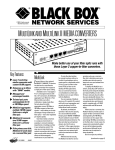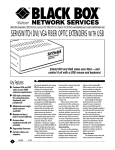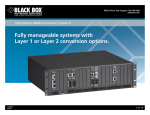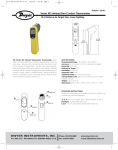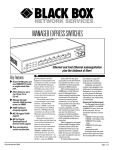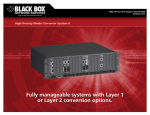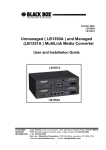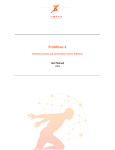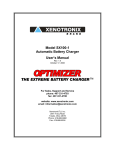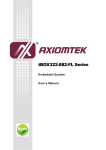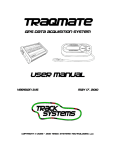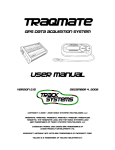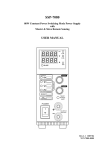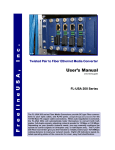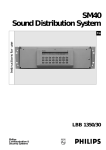Download Make better use of your fiber optic runs with these Layer
Transcript
FREE 24-hour Tech Support: 724-746-5500 blackbox.com © 2007. All rights reserved. Black Box Corporation. MultiLink and MultiLink II Media Converters Make better use of your fiber optic runs with these Layer 2 copper-to-fiber converters. Corporate Network Application FEATURES • Layer 2 switching media conversion with custom VLAN support. • Distances up to 40 kilometers with ”SM40” models. • Managed and unmanaged models. • Twisted-pair ports autonegotiate for 10- or 100-Mbps speed. • MultiLink aggregates multiple 10/100 copper links over a single fiber pair. • MultiLink II connects two 10/100 copper links over a primary fiber pair. • If the primary one fails, MultiLink II sends data via a second fiber pair. • Daisychain MultiLink II in a ring or string topology to extend your network. MultiLink Media Converter, Managed Multimode ST (LB1350A-ST) Managed Express Ethernet Switch (LB9030A) High-Density Media Converter II Chassis (LMC5201A) with 10-/100-Mbps Module (LMC5119C) High-Density Media Converter II Chassis (LMC5201A) with 10-/100-Mbps Module (LMC5118C) Department C MultiLink Media Converter, Managed Multimode ST (LB1350A-ST) Department A Department B MultiLink Media Converter, Managed Multimode ST (LB1350A-ST) Redundant Link Application MultiLink II Media Converter, Managed Multimode SC (LB1302A-SC) Express Ethernet Switch (LB9021A) Main fiber link at 1000 Mbps Connection to other high-speed networks Backup fiber link Express Ethernet Switch (LB9021A) Main fiber link at 100 Mbps Servers PC Ring Topology Application Remote 3—PCs Remote 5—Cameras Remote 6— Remote connection Express Ethernet Switch (LB9021A) MultiLink II Media Converters, Unmanaged, Multimode SC (LB1301A-SC) MultiLink II Media Converters, Unmanaged, Multimode SC (LB1301A-SC) Remote 1— Wind farm Remote 2— Water treatment 4/24/2007 #26437 724-746-5500 blackbox.com Remote 4— Network servers 2 of 5 OVERVIEW The MultiLink and MultiLink II are sophisticated Layer 2 media converters that enable you to not only extend your network over fiber, but to combine two, three, or four copper ports over a single or dual fiber link. Because you’re getting more use from each fiber optic cable, you save on cabling costs. The MultiLink and MultiLink II feature buffering technology that enables you to communicate across greater distances and provide greater flexibility for planning a network. Because these devices rely on non-repeater, fullretiming technology, they won’t contribute to your network’s repeater count. Three separate functions in one unit: • Secure Ethernet Switch: Ethernet switching that keeps each copper port isolated in its own secure VLAN-protected broadcast domains. • Ethernet Switch: In this application, the MultiLink and MultiLink II operate as a conventional Ethernet switch. • Media Converter: MultiLink and MultiLink II can also be used as simple Layer 2 copper-to-fiber media converters. Secure Ethernet switch functionality MultiLink and MultiLink II keep each 10BASE-T/100BASE-TX port isolated in secure VLAN-protected broadcast domains. Each fiber port has a broadcast domain, too, but it’s also a ”member” of the copper domains. This means users attached to the copper ports can network with resources attached to a fiber port only. With this level of security, the MultiLink is ideal for service providers who use a common fiber link to distribute services to multiple users but also want to keep each user port isolated from other user ports. Ethernet switch functionality To deploy the MultiLink or MultiLink II as an ordinary Ethernet switch, just flip a DIP switch on the front panel. Doing this disables port-based VLANs pre-set in the firmware and puts all ports within the same bandwidth domain. You can then operate the MultiLink as a conventional store-andforward switch, complete with a 1K MAC address table and 300 seconds aging. Media converter functionality When used as a converter, the MultiLink or MultiLink II provides Layer 2 copper-to-fiber conversions while autonegotiating 10-/100-Mbps connections on the copper side and making 100-Mbps connections on the fiber side. In most cases, the copper ports automatically adapt to work at the highest possible performance (although forced operation may be required in some situations). Many 100BASE-TX to 100BASE-FX media converters use repeater technology, so they become 4/24/2007 #26437 724-746-5500 blackbox.com part of the collision domain, introduce additional delay to the network, and contribute to the repeater count. With MultiLink Converters you have no such worries. They take a non-repeater, full-retiming approach by creating a Buffered Media Domain (BMD). Easy setup and troubleshooting The autonegotiating twisted-pair ports adapt automatically to the highest performance possible, whether it’s 10- or 100-Mbps speeds or half- or full duplex. And the autocross function on copper ports means there’s no need to swap out straight-through cables for crossover ones. All models have a Far End Fault (FEF) feature. When enabled, FEF alerts you to problems on the connected fiber optic segment. If fiber optic link loss is detected on the remote side, and if the remote device supports FEF, a Far End Fault signal is relayed back to the local device, alerting you to ”silent failures” on your network through an LED. Front-panel diagnostics inform you of every port’s operating mode. Each copper port has three status LEDs (link/activity, duplex mode, and connection speed) and each fiber port has two status LEDs (link/activity and duplex mode). Install the MultiLink or MultiLink II in a 19" rack or cabinet or simply use as a desktop device. Three mounting holes enable the unit to be installed either horizontally or vertically on a wall. Choose managed models for extra control Managed models of the MultiLink and MultiLink II have a front-panel console port for access to management features. Manage them using full, in-band SNMP via a management station platform such as HP® OpenView® and SNMPc, by loading a MIB file when configuring the device. Using the terminal connection, you can override DIPswitch settings and monitor the device. A basic text menu prompts you through all options for setting network, console, and SNMP parameters. Port priority schemes on managed models enable you to specify high or low priority to traffic it processes. This can be done on a per-port basis, in which all traffic from a specified input port is considered high priority, or through 802.1 Port Priority, in which the inbound port examines the priority field within a VLAN tag to determine high or low priority. Set outbound priority, too, through the DSCP Port Priority function. Managed models also offer protection against broadcast storms, activity which can overload your network and slow it down. To counter this type of activity, the managed MultiLink and MultiLink II models enable you to specify the relative amount of broadcast traffic that can be forwarded by the device, as much as 25% and as little as 3%. 3 of 5 MultiLink Daisychain for network extension The MultiLink aggregates as many as four Ethernet or Fast Ethernet links over a single pair of multimode or single-mode fiber. The unmanaged version (LB1350A) can be set for bandwidth priority on the fourth UTP port. This ”preferred” port can be used for a user who needs a lot of bandwidth. Use these media converters in a campus environment, for example, to connect individual departments or buildings via fiber to your enterprise switch. This way, you not only stretch your network connections but increase data security while minimizing the effects of electromagnetic interference on your data links. MultiLink is also the ideal solution for remote locations with just a handful of workstations and no great need for a dedicated switch or hub. Or use it in fiber-to-the-home (FTTH) or fiber-to-the-desktop (FTTD) applications. You can connect four homes or workstations to a fiber optic backbone over one pair of fibers with the MultiLink. Set up to operate as a 4-port switch, the MultiLink II can operate as an add-drop multiplexor (ADM) access device for interconnecting dozens of network devices within a ring or string architecture. Setting up your network with ring or string configurations enables you to do a lot more with less fiber. It‘s particularly useful in highway or railway control or video surveillance applications where you want to interlink control or surveillance stations over fiber optic. Specifically, you can place a MultiLink II at each station in the ring or string, with one 100BASE-FX port on each unit devoted to an upstream MultiLink II connection and the other 100BASE-FX port linked to the downstream MultiLink II connection. At each station, you can then connect control and monitoring equipment via twisted-pair cable to the MultiLink II’s two 10BASE-T/100BASE-TX ports. By creating a Buffered Media Domain (BMD), the MultiLink II enables you to extend a network in any network architecture—no matter how many repeaters are present— and still see maximum performance. You can expect this performance even in a network where your interconnected devices operate at different rates and modes. MultiLink II The BLACK BOX® MultiLink II features two copper ports and two fiber ports. The buffered twisted-pair ports offer VLAN protection between them. The second fiber port provides the means to add a redundant fiber link and can also be used to install MultiLink II in a ring or string topology to extend your network. Redundant link for emergency backup Combine two copper ports across one fiber link with another fiber link in reserve as a backup in case the primary link goes down. When used to establish a redundant link, the MultiLink II is ideal for a mission-critical application. It gives you peace of mind when you want to be sure that the connection between your network devices and fiber infrastructure is always available. In a typical redundant-link application, a pair of MultiLink IIs are installed between network devices and the fiber optic cable, with each unit having two ports connected between them— one for primary communications and the other for standby. If the primary fiber link fails, the MultiLink II units recognize the loss of link signals and automatically switch communications from the primary to the backup fiber link. When link signal is restored to the primary link, communications are automatically switched back to it. (NOTE: You can also use a single MultiLink II to establish a backup fiber optic link, but you must first ensure that the fiber devices attached to its ports support this type of configuration.) 4/24/2007 #26437 724-746-5500 blackbox.com WHAT‘S INCLUDED ✦ Media converter unit ✦ Strip of (4) adhesive plastic feet for anti-skid desktop placement ✦ (1) AC power cord ✦ User manual ✦ Managed models only: (1) 6 foot (1.8-m) 4-pin DIN male to DB9 female console cable ✦ Managed models only: Floppy diskette with MIBs 4 of 5 TECH SPECS LB1350A-SC MultiLink Converters: Approvals — UL® 1950, 1955, EN60950; FCC Part 15, Subpart A, Class A, VCCI Class; ICES; EMC; CE Conversion Method — Buffered Media Domain (BMD) Distance (Maximum) — LB1350A-SC, LB1350A-ST, LB1351A-ST: 2 km (1.2 mi.); LB1350A-SM15, LB1351A-SM15: 15 km (9.3 mi.); LB1350A-SM40, LB1351A-SM40: 40 km (24.9 mi.) Hardware Type — Store-and-forward, wire-speed, non-blocking switch MIBs Supported — Managed models only: MIB II (RFC 1213, 1215), RFC 2474 (DSCP), private MIBs Protocol — Transparent, auto-learning switch Speed (Maximum) — Switching fabric: 1.4 Gbps; On UTP and fiber optic ports: 10 or 100 Mbps (half-duplex), 20 or 200 Mbps (full duplex) Standards — IEEE 802.3u, IEEE802.1p, 100BASE-TX, 100BASE-FX, 10BASE-T, FDX flow control, HDX back pressure flow control Connectors — LB1350A models: (4) RJ-45, (1) pair SC or ST; LB1351A models: (3) RJ-45, (1) pair ST, (1) 4-pin DIN (RS-232); All: (1) 3-prong IEC power Indicators — All: (12) LEDs: (3) per each 10/100 port: Link/Activity, FDX, 100M; (2) on fiber optic port: Link/Activity, FDX; (1) Power; (1) Test; LB1351A models also have (1) RCV and (1) Ready LED Temperature Tolerance — Operating: 32 to 113ºF (0 to 45ºC); Storage: -4 to +176ºF (-20 to +80ºC) Humidity Tolerance — 10 to 90% noncondensing Power — 100–240-VAC, 50–60-Hz, autosensing internal power supply Size — 1.7"H x 8.8"W x 5.9"D (4.3 x 22.4 x 15 cm) Weight — 1.3 lb. (0.6 kg) MultiLink II Converters: Approvals — UL 1950; FCC Part 15, Class A; CE Conversion Method — Buffered Media Domain (BMD) Distance (Maximum) — LB1301A-SC, LB1301A-ST, LB1302A-SC, LB1302A-ST: 2 km (1.2 mi.); LB1301A-SM15, LB1302A-SM15: 15 km (9.3 mi.); LB1301A-SM40, LB1302A-SM40: 40 km (24.9 mi.) Hardware Type — Store-and-forward, wire-speed, non-blocking switch MIBs Supported — Managed models only: MIB II (RFC 1213, 1215), RFC 2474 (DSCP), private MIBs Protocol — Transparent, auto-learning switch Speed (Maximum) — Switching fabric: 1.4 Gbps; On UTP and fiber optic ports: 10 or 100 Mbps (half-duplex), 20 or 200 Mbps (full duplex) Standards — IEEE 802.3u, IEEE802.1p, 100BASE-TX, 100BASE-FX, 10BASET, FDX flow control, HDX back pressure flow control Connectors — LB1301A models: (2) RJ-45, (2) pair SC or ST®; LB1302A models: (2) RJ-45, (2) pair SC or ST, (1) 4-pin DIN (RS-232); All: (1) 3-prong IEC power Indicators — All: (12) LEDs: (3) per each 10/100 port: Link/Activity, 100M; (2) on fiber optic port: Link/Activity, FDX; (1) Power; (1) Test; LB1302A models also have (1) RCV and (1) Ready LED Temperature Tolerance — Operating: 32 to 113ºF (0 to 45ºC); Storage: -22 to +149ºF (-30 to +65ºC) Humidity Tolerance — 10 to 90% noncondensing Power — 100–240-VAC, 50–60-Hz, autosensing internal power supply Size — 1.6"H x 8.7"W x 5.9"D (4.1 x 22.1 x 15 cm) Weight — 2 lb. (0.9 kg) Item Item MultiLink Media Converters Managed, (3) 10BASE-T/100BASE-TX to (1) Multimode, 1310 µm, 2 kilometers SC ST (1) Single-Mode, 1310 µm, 15 kilometers SC (1) Single-Mode, 1310 µm, 40 kilometers SC Unmanaged, (4) 10BASE-T/100BASE-TX to (1) Multimode, 1310 µm, 2 kilometers ST (1) Single-Mode, 1310 µm, 15 kilometers SC (1) Single-Mode, 1310 µm, 40 kilometers SC 4/24/2007 #26437 724-746-5500 blackbox.com Code LB1350A-SC LB1350A-ST LB1350A-SM15 LB1350A-SM40 LB1351A-ST LB1351A-SM15 LB1351A-SM40 MultiLink II Media Converters Unmanaged, (2) 10BASE-T/100BASE-TX to (2) Multimode, 1310 µm, 2 kilometers SC ST (2) Single-Mode, 1310 µm, 15 kilometers SC (2) Single-Mode, 1310 µm, 40 kilometers SC Managed, (2) 10BASE-T/100BASE-TX to (2) Multimode, 1310 µm, 2 kilometers SC ST (2) Single-Mode, 1310 µm, 15 kilometers SC (2) Single-Mode, 1310 µm, 40 kilometers SC For optimum performance, order… Duplex Fiber Optic Cable, PVC, ST–ST Custom Lengths Multimode Duplex Fiber Optic Cable, PVC SC–SC, Custom Lengths Single-Mode Duplex Fiber Optic Cable, PVC SC–SC, Custom Lengths Code LB1301A-SC LB1301A-ST LB1301A-SM15 LB1301A-SM40 LB1302A-SC LB1302A-ST LB1302A-SM15 LB1302A-SM40 EFN062-CC EFN4025 EFN5010 5 of 5





